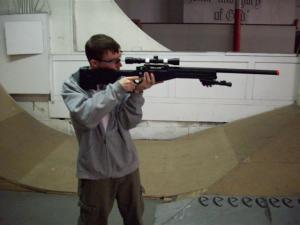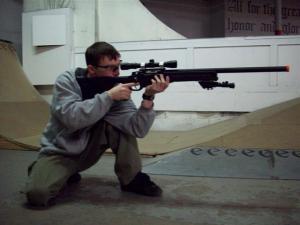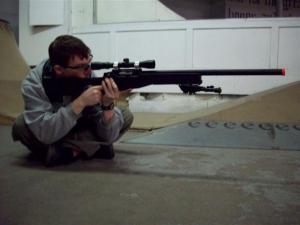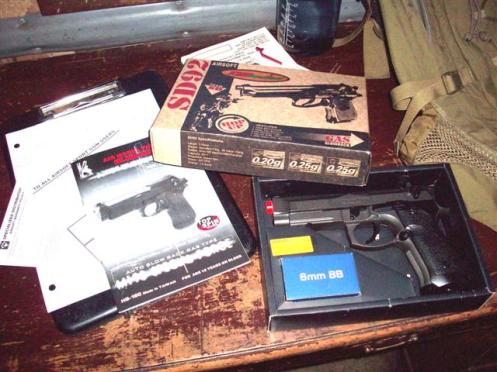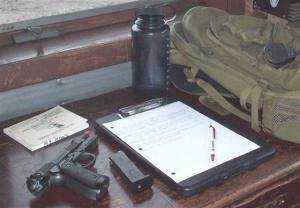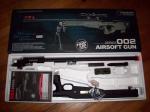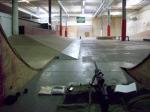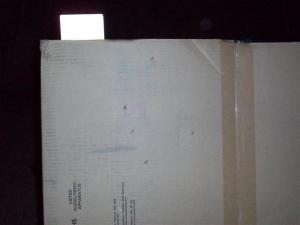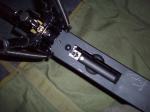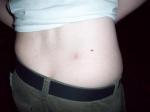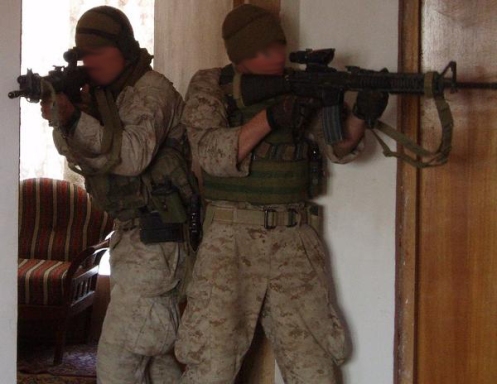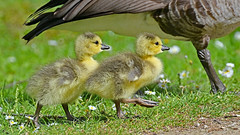I had the opportunity to attend the national level event, OP: Irene X, as a guest of sponsor Evike.com (who is also a sponsor of Airsoft Commando and NYC Airsoft). This was the first time I participated any event this large. The majority of my experience started with small games with friends in Northern Minnesota, transitioned to small regional games hosted by Filforce in NY/NJ, and in recent years, large events hosted by NYC Airsoft for the whole East Coast (Evike.com gave away 6 boxes of guns and gear at the last OP: Bad Blood…which teams I commanded has won every single year since 2008 ;p ).
Prior to airsoft I served four years active duty USMC finishing out my contract with 3/1 STA. I have only participated in one large scale (300+ people) training event, though that experience is irrelevant considering large events generally only evaluate command and control rather than small unit ability (despite what they say). However, my extensive airsoft experience, coupled with years of operational experience and small-unit training, I believe provide me with a strong foundation with which to evaluate this event.
Evike.com also sent along Primer from team Violence of Action (VOA) and we made a roleplaying staff team alongside team members of EAGLE and Blacksheep. For the initial portion of the scenario we were the Muscatuck National Army (MNA) wearing all black and later roleplayed local warlord militia wearing snowflage (or “urban” for the uneducated). The vast majority of my airsoft arsenal has come straight from Evike as sponsor gear. My gear is genuine combat quality kit I know is good because I have bet on it in my previous life, no Condor or Flyye for me (though I’m sure it’s a suitable and affordable alternative for young airsofters). I have an M4/M203 Matrix Customs (impeccably organized internals) I intended to use, but even as a stock gun, it was shooting 388 feet per second (FPS) using .25g BBs which is much too hot for this event and many others. I was fortunate enough to be loaned the gun Polarstar (P*) had set aside for the raffle. After brushing aside the guilt of devirginizing someone’s new gun that was going to be signed by MSG Howard “Mad Max” Mullen, I got rigged up. Those P* guys were right, loaning out guns is a great marketing idea because whoever plays a game with one is 99% likely to buy one. It changes the whole feel of airsofting. It made me feel so…ninja.
+Sideline+ On P*
Primer had an Echo1 SCAR to loan me, but the Polarstar (P*) booth set me up with the raffle gun. It was sick. So sick. It’s hard to go back to an AEG after that. The tank and hose are hardly noticeable and it’s a no-brainer when you’re weighing the Pros and Cons. The consistency and trigger response are choice. That particular gun wasn’t impressively accurate and the rate of fire was set to an ideal rate. I found myself shooting semi-auto even outdoors anyway. Primer had his set to a 6 shot burst when switched to full-auto. I don’t think it would be too difficult to accurize it with a little polish, nice inner barrel, and heavy (.3g or higher) BBs. I used the P* all day Saturday, and then Primer’s SCAR Sunday. I actually really liked the SCAR. It was shooting super slow, but it shot like a laser. To be honest, if I had known it would be so accurate, I might have used the SCAR instead of the Polarstar. The Scout/Sniper in me puts accuracy first, but really, I couldn’t pass up the chance to run a P* and really give it a solid test run. Primer didn’t seem to have a problem getting his P* as accurate as his SCAR, but the one I was using was just a P* Commercial-Off-The-Shelf rig. I want a P*.
The P* guys told me that the V3 engine should go public by Christmas 2012. It’s technically ready, but they are trying to test many V3 variants to get it as widely compatible as they can. They also had a M240B, M249, and RPK on display. Rumor was they were using them in the game too, but I never used them. I only fired the M4 and a M110 models. All were very nice. I was told they also were working on a non-electric version that would run only on air. Ben said, “…come up out of the water firing.” Seems ubersex to me. They are working on training weapons specific for MIL/LE and even are in partnership with another guy who is trying to replace MILES system for the military and has a hit sensitive vest that can work in conjunction with the weapon to deactivate it when you are officially hit.
If you’re the kind of airsofter who needs a M40A3 P*-type rifle with the rig fully integrated into the McMillian stock and can spend several thousand dollars to buy a unique proof-of-concept airsoft gun. Scuttlebutt says you should ask around for Ben Noji.
+End Sideline+
I certainly enjoyed the event. Being placed on the Staff Roleplayer team didn’t afford me much of a look at the missions and objectives, but I did get a unique look at how both teams got utilized. A couple individuals I talked with spent the entire game dumping thousands of rounds (behooves you to get a SAW slot), and others who ended up on guard duty. Since there were multiple scenarios (Saturday had 3: breakfast to lunch, lunch to dinner, “night”. Sunday breakfast to late lunch) I would assume the commanders rotated the squads through responsibilities so everyone got their money’s worth, but I met one man who was frustrated at his lack of engagements.
Which seems odd to me. There were nearly 600 players including the staff, and there was less than 100 staff. It should be a target rich environment. It seems that even an expensive, well-organized, well-executed scenarios game still is plagued by “airsofting”. All scenarios and games will be what you make of them. Just as people sit behind cover at the very edge of their maximum range swapping plastic with each at small local games, they do it that much more at big games. Again, I’m not sure the respawn policy for regular players, but everyone seems terrified of taking a hit, which holds them back from really getting into the game.
The Area of Operations (AO = skirmish field) was pretty dynamic. There were furnished buildings, “bombed out” structures, and little shacks. Debris and alleyways were everywhere. Smoke machines constantly pumped at random points and gas fires set in engine blocks and vehicles would randomly “explode”. It actually made me a little jumpy from time to time. Some buildings were quite difficult to assault, with others being so exposed to the outside you had to be very conscious of your movement inside. A few of the buildings even had ladder access to the roof which was about three stories up.
Being role players was a little frustrating at first, because how we were attempting to facilitate the game wasn’t entirely clear. Both teams looked at us as a rival team instead of storyline characters. It made it difficult to accomplish a new task, such as making liaison with the commander to discuss NATO personnel in hiding, when they would shoot us on sight because in the last scenario our task was create green-on-blue incidents. But really, that’s understandable. Not everyone is always on the same page about what is happening. Like players calling our hits for us or telling us we are not doing something right even though we are there to help their game along, not be airsoft ninjas. Like, “Really? You think I’m not calling my hits because it matters whether I get out or not?”
These are issues present at every level of training and gameplay, whether airsoft or the big leagues. It’s not until the bullets are calling hits for you that any of this goes away…and that sucks. It’s part of the game, so adapt, overcome, and enjoy the sport with its limitations, not despite them.
Saturday
Our squad-sized unit began play portraying a rabble of Muscatuck National Army. Our first task was to being trained by a Delta team cadre before accompanying us on a raid of a local insurgent village. Their points depended on the clearing of the village and our performance depended on how well we figured they “trained” us. A man with the nametape “Smith” conducted our basic training. He introduced himself as a Special Forces veteran and then gave 15-20 minutes of hands on instruction that convinced me. Judge a man by what he shows you, not what he tells you. It was a hopeless task however. We fought to take that village with every fiber, but it simply wasn’t happening.
As we, accompanied by a squad of Delta, patrolled to the village utilizing defilade to flank it, basic patrol techniques were either unknown or disregarded. A few members sky lined themselves over the ridge and were seen by the insurgent element played by Charlie. A Nerf rocket sailed in moments later, eliminating roughly one-quarter of our personnel and dividing the ranks. Only one MNA was lost, and Delta, who hadn’t received our special ODA training (which I thoroughly enjoyed. A highlight of my experience.), fully realized the painful lesson in the importance of dispersion. I pushed on in our planned route, which ended up being only a fire team sized element, which quickly dwindled to only Primer and I. We used Fire-and-Movement to get nearly into the village before getting toasted. Primer was hit on his dash from the car to the building and I when OpFor popped a corner cleanly. I may have hit one or two Charlie utilizing the Drake Shoot, but Primer got most of them I believe. Another MNA we discovered as the walking dead had made it to the roof of one building but couldn’t move from it without any buddies, who all were out by then.
Apologies to Delta for not getting them max points. We did have to assault the high ground (pairs of enemy on roofs and in doorways), and do this across open ground using AEGs with a max of 150ft of range…and they all took their hits first.
From their we established our MNA HQ from which to respond to calls from the local Police role players (MPD) if either team was violating Civilian role players in whatever ways. Within an hour, we were enemies of both factions. There were many firefights we participated in on both sides of the conflict to facilitate the story line. There were two of note during this period.
Firefights
The first wasn’t much of a firefight. A player had been left on a roof to defend it. I’m having trouble remember which side now, but I think it was Delta. We received a request to investigate this given our general non-combatant role. Sole access to the roof was up a 15 foot ladder in a 2nd floor closet and through an access hatch. An MNA began climbing and within 2 feet of the top, began back down saying he was dead. The next did the same thing with the same results (surprise, right?). I knew what would happen, but we needed a clear ROE violation to pass over the radio, so I was next. I announced, “MNA, neutral,” repeatedly all the way up the ladder and was met with a safety kill just the same. I detest safety kill rules, but they ARE the rules. Continuing my climb to assess the situation, I found one lone player, impressively successful in carrying out his orders to kill anyone coming onto the roof. No amount of grenades or entry techniques could have root him out (in airsoft anyway). We reported it before leaving to go about other tasks. He didn’t violate any rules despite the other teams protests that he did. However, to facilitate the flow of the game, he was administratively disarmed and removed. I believe he was given to MPD to be escorted to a trial scene of some sort, but both teams cut everyone down on sight. None survived.
I took this experience with me as I led a 3-man team into another identical building held by Delta. We had been tasked with clearing that building of foreigners so it could be used by civilians or some such fantasy scenario. Who cares? Airsoft time! It is best to clear a building from top down, so we have to start at the roof somehow. Using this technique, you give the enemy a place to run, rather than fight, and your security element (which we didn’t have) can pick them off from cover in open ground. Primer and I had picked up another player randomly who wore GI-issue ACU. I only knew that he was going to run with us, but he didn’t seem like he knew airsoft. We three entered the building through the rear entrance. We stayed quiet and narrowly avoided the occupants all the way up to the roof access. At one point it was extremely Metal Gear with their backs to us. So exciting! I slung my rifle, drew my pistol and began to climb. I assumed the scenario would go much the same as the other roof. It didn’t.
Here the security man, this squads leader, was chilling against the side of the roof without a weapon in his hand. Barely clearing my eyes and muzzle out the hatch, I engaged him with about 10 rounds of 6mm from my KWA G19 (CO2 extended mag). He called his hit, realized no one else heard him, and called it louder as an alert to his squad. I peered around the roof, and saw about 10-12 guys on the other side engaging targets below. He smiled and shrugged and I made my exit. I think I smiled back but I was getting tunnel vision. I holstered my pistol, pulled out my P* M4 and stepped onto the roof. I got low and took up a defensible position. Still no one noticed. I called the others up, telling them to be quiet and quick. Our mysterious friend reached the top, but Primer never came. I asked about him, but ACU was clueless. So we moved on. I got him in a firing position on the right side of the hatch and told him to wait for me to start shooting. Then he would shoot the right most man, then work toward his left. I got into my position and the turkey shoot began. I worked from left to right until all targets were down. They were confused and mad. So mad. Two targets were even in line with each other and the man behind coordinated his dead buddy as cover. Devious, but I read it and he called his hit anyway. Pretty sure I started shooting his “cover” even before the move. Then a BB skipped right off my forehead. I called my hit to figure out how one got through. There was only three enemy on the roof I couldn’t engage myself due to the layout and ACU-man should have had no problem. I slipped a little into Marine-mode when I was trying to figure out how he screwed it up. Apparently he stopped shooting after the first two because I only told him those two…the last guy killed us both.
Before descending, I had the decency to gloat a little to all the dead. One Delta commander popped his head through the hatch and seemed a little awed at what happened. I asked if he killed my security man at the bottom of the ladder, but he didn’t. He had no idea what was going on until he popped his head up. I later found out from Primer that he was holding security when the whole squad walked in and rather than get shot up he just said, “Hey, what’s up?” gave a smile, and left! We had a pretty good laugh. I wish he had come up and the other guy had stayed useless on security. Found out later that guy was a National Guard facility guy of some kind and they just gave him an airsoft rifle to give him a taste. I tried to take him under my wing, but he ended up disappearing and I never saw him again.
Hostage Rescue
That evening all the roleplayers were taken to two separate buildings. Each guarded a down pilot for the teams to rescue. We took up strong points and made them earn it. Four of us on the bottom floor must have dropped twenty OpFor (with continual respawn) before they were able to move upstairs. Both teams were able to secure their objective. It was an incredible firefight. It was inevitable they would be able to get us all, but the teams were timed against each other, and they couldn’t accidentally shoot the hostage. I am surprised neither did.
Of note in this scenario was the flawed concept of “stacking”. Stay close to your buddy, but stacks are an extremely advanced method of recapture that is much more involved than simple room entry techniques. People had trouble clearing the fatal funnel and caused gameplay trouble when they blocked the fatal funnel when they were hit which made their buddies sitting ducks in their beloved stack. CQB against entrenched enemy who want to fight is a suicide trip. In the real world, you need to cheat, blow holes in walls or floors, frag every single room three times, and jump to the next building to fight from the top down. In airsoft, the playing field is mostly level. Just like when I was training in the USMC with Simunition, against a fighting enemy, if you take double the amount of shooters against the enemy, 80% aren’t going to make it. Get Thunder Bs and Tornados and apply them liberally indoors. Then get out of the way.
Sunday
Sunday found us tasked with guarding a “UN Food Depot” that both teams had to secure bags and crates from for points. As both teams approached within firing range, we played out a scene where the civilians rioted and ran off with the items. We set chase firing wildly all over (but never hitting the civilians) to recover the food and return it to the pile. Our goal was to get one of the teams to violate ROE and kill a civilian in order to secure some of the food. It wasn’t too long before a Charlie with sergeant stripes ran up to the three of us and popped us all with a pistol and ran off with the jerry can prop! After I stopped laughing, we sent the info up the chain, and the gloves were ordered off.
I don’t know what the objectives were for either team, but we were tasked with creating chaos all over. We tried to give everyone more trigger time than they could handle. We scouted around for groups just sitting in buildings or behind bunkers and ambushed them. It was great fun, if kind of unfair from their perspective. We popped in an out of play with red rags on just to find people and get them moving and into the action. It was very entertaining.
Thanks to Evike.com for sending me as their brand rep. I tried to give some patches and swag to the guys from Parafrog, but they declined. Sorry.

